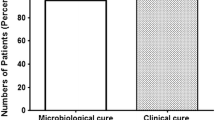Summary
A multicenter trial on the efficacy and tolerability of ofloxacin in upper and lower respiratory tract infections and urinary tract infections was carried out on 1,436 patients (926 males and 510 females; mean age 55.9 ± 18.4 years). Three dosage regimens were randomly applied: 200 mg, 300 mg and 400 mg ofloxacin b.i.d. by the oral route. The overall clinical outcome expressed as the ratio of the number of patients cured and improved to the number of patients treated was 279/324 (86%) in upper respiratory tract infections; 612/667 (91.8%) in lower respiratory tract infections and 418/445 (93.9%) in urinary tract infections. Out of 872 bacterial strains isolated in 802 patients, 742 (85.1%) were eradicated. Side effects not requiring interruption of therapy were observed in 65 patients (4.5%), while interruption was necessary in 23 patients (1.6%). The most frequent side effects were gastrointestinal disturbances. In conclusion ofloxacin showed a good clinical efficacy and tolerability in the treatment of respiratory and urinary tract infections.
Zusammenfassung
Bei insgesamt 1436 Patienten (926 Männer und 510 Frauen) mit einem mittleren Alter von 55,9 ± 18,4 Jahren wurde Ofloxacin zur Behandlung von Infektionen der oberen oder tiefen Atemwege oder von Harnwegsinfektionen eingesetzt und seine Wirksamkeit und Verträglichkeit geprüft. Zufallsgemäß wurden drei Dosierungen verabreicht: 200 mg, 300 mg oder 400 mg Ofloxacin zweimal täglich per os. Das klinische Gesamtergebnis, ausgedrückt durch den Quotienten aus der Anzahl geheilter und gebesserter Patienten zur Anzahl behandelter Patienten war bei Infektionen der oberen Atemwege 279/324 (86%), bei tiefen Atemwegsinfektionen 612/667 (91,8%) und bei Harnwegsinfektionen 418/445 (93,9%). Bei 802 Patienten wurden 872 Bakterienstämme isoliert, davon wurden 742 (85,1%) eliminiert. Bei 65 Patienten (4,5%) wurden Nebenwirkungen beobachtet, die einen Therapieabbruch nicht erforderlich machten. Bei 23 Patienten (1,6%) mußte die Therapie wegen Nebenwirkungen beendet werden. Als häufigste Nebenwirkungen traten gastrointestinale Beschwerden auf. Insgesamt war bei der Behandlung von Atemwegsinfektionen und Harnwegsinfektionen mit Ofloxacin eine gute klinische Wirksamkeit und Verträglichkeit festzustellen.
Similar content being viewed by others
Literature
Sato, K., Matsuura, Y., Inove, M., Une, T., Osada, Y., Oyawa, H., Mitsua Hashi, S. In vitro andin vivo activity of DL-8280, a new oxazime derivative. Antimicrob. Agents Chemother. 22 (1982) 548–553.
Verho, M., Dagrosa, E. E., Malerczyk, V. Klinische Pharmakologie von Ofloxacin: Ein neues Chemotherapeutikum aus der Reihe der Gyrasehemmer. Infection 14 (1986) S47-S53.
Blomer, R., Bruch, K., Zahlten, R. N. Zusammengefaßte Ergebnisse der klinischen Phase II- und III-Studien mit Ofloxacin (HOE 280) in Europa. Infection 14 (1986) S102-S107.
Sherry, S., Gent, M., Lilienfeld, A., McGregor, M., Mustard, J. F., Yu, P., Cartwright, K., Ellis, L. A., Cohen, M. D. The anturane reinfection trial: evaluation of outcome. N. Engl. J. Med. 306 (1982) 1005–1008.
Author information
Authors and Affiliations
Rights and permissions
About this article
Cite this article
Grassi, G.G. A multicenter study on clinical efficacy of ofloxacin in respiratory and urinary tract infections. Infection 14 (Suppl 4), S300–S302 (1986). https://doi.org/10.1007/BF01661299
Issue Date:
DOI: https://doi.org/10.1007/BF01661299




